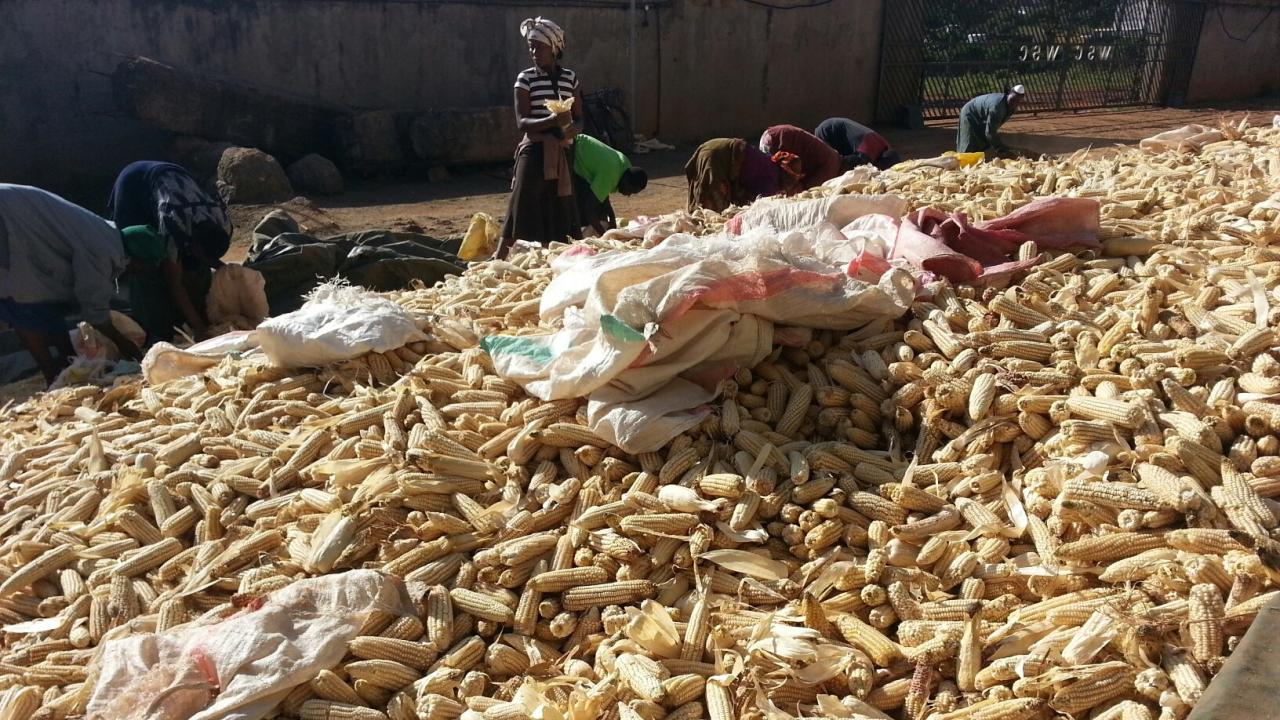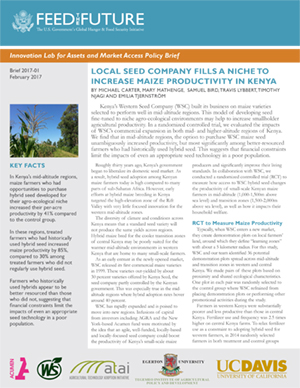
Kenya’s Western Seed Company (WSC) built its business on maize varieties selected to perform well in mid-altitude regions. This model of developing seed fine-tuned to niche agro-ecological environments may help to increase smallholder agricultural productivity. In a randomized controlled trial, we evaluated the impacts of WSC’s commercial expansion in both mid- and higher-altitude regions of Kenya.
We find that in mid-altitude regions, the option to purchase WSC maize seed unambiguously increased productivity, but most significantly among better-resourced farmers who had historically used hybrid seed. This suggests that financial constraints limit the impacts of even an appropriate seed technology in a poor population.
Key Facts
- In Kenya’s mid-altitude regions, maize farmers who had opportunities to purchase hybrid seed developed for their agro-ecological niche increased their per-acre productivity by 41% compared to the control group.
- In these regions, treated farmers who had historically used hybrid seed increased maize productivity by 85%, compared to 30% among treated farmers who did not regularly use hybrid seed.
- Farmers who historically used hybrids appear to be better resourced than those who did not, suggesting that financial constraints limit the impacts of even an appropriate seed technology in a poor population.
 Roughly thirty years ago, Kenya’s government began to liberalize its domestic seed market. As a result, hybrid seed adoption among Kenyan maize farmers today is high compared to many parts of sub-Saharan Africa. However, early efforts at hybrid maize breeding in Kenya targeted the high-elevation zone of the Rift Valley with very little focused innovation for the western mid-altitude zones.
Roughly thirty years ago, Kenya’s government began to liberalize its domestic seed market. As a result, hybrid seed adoption among Kenyan maize farmers today is high compared to many parts of sub-Saharan Africa. However, early efforts at hybrid maize breeding in Kenya targeted the high-elevation zone of the Rift Valley with very little focused innovation for the western mid-altitude zones.
The diversity of climate and conditions across Kenya means that a standard seed variety will not produce the same yields across regions. Hybrid maize bred for the cooler transition zones of central Kenya may be poorly suited for the warmer mid-altitude environments in western Kenya that are home to many small-scale farmers.
As an early entrant in the newly opened market, WSC released its first commercial maize varieties in 1999. These varieties out-yielded by about 30 percent varieties offered by Kenya Seed, the seed company partly controlled by the Kenyan government. This was especially true in the midaltitude regions where hybrid adoption rates hover around 40 percent.
WSC has rapidly expanded and is poised to move into new regions. Infusions of capital from investors including AGRA and the New York-based Acumen fund were motivated by the idea that an agile, well-funded, locally-based and locally-focused seed company could boost the productivity of Kenya’s small-scale maize producers and significantly improve their living standards.
In collaboration with WSC, we conducted a randomized controlled trial (RCT) to measure how access to WSC hybrid seed changes the productivity of small-scale Kenyan maize farmers in mid-altitude (1,000-1,500m above seal level) and transition zones (1,500-2,000m above seal level), as well as how it impacts their household welfare.
RCT to Measure Maize Productivity
Typically, when WSC enters a new market, they create demonstration plots on local farmers’ land, around which they define “learning zones” with about a 5 kilometer radius. For this study, WSC and our team identified 36 potential demonstration plots spread across mid-altitude and transition zones in western and central Kenya. We made pairs of these plots based on proximity and shared ecological characteristics. One plot in each pair was randomly selected to the control group where WSC refrained from placing demonstration plots or performing other promotional activities during the study.
Farmers in western Kenya were substantially poorer and less productive than those in central Kenya. Fertilizer use and frequency was 2.5 times higher on central Kenya farms. To relax fertilizer use as a constraint to adopting hybrid seed for western farmers, in 2014 we gave randomly selected farmers in both treatment and control groups 50 kg of high quality fertilizer.
Our 1,200 farmers in western Kenya were randomly assigned into four groups:
- Seed Only: received WSC information and free 250-gram trial seed packets in 2013, WSC information in 2014 and WSC information and an option to have WSC deliver to their homes in 2015
- Fertilizer Only: received fertilizer in 2014 but otherwise received no treatment
- Seed and Fertilizer: received the same treatments as Seed Only and Fertilizer Only
- Control: received no treatment
Within our western sub-sample farmers in the transitional zone used hybrids in more than 7.5 of the 10 growing seasons prior to our study, on average, compared with fewer than 4 seasons for mid-altitude farmers, on average. This brief focuses on differences in productivity between these mid-altitude and transition zones within western Kenya as well as between past users and non-users of hybrid seed.
Biggest Increase for Prior Hybrid Use
In western mid-altitude areas, farmers in the Seed Only group boosted maize productivity per-acre by 41 percent on average relative to the control group. The yield gain for those who actually adopted WSC maize seed was several times higher. Adoption of WSC maize seed in the Seed Only group was 17 percentage points higher than the control group adoption rate of 2 percent.
The transition zone plots in the Seed Only group were no more productive than control plots who received no information or seed packets from WSC. It appears that WSC varieties were no more productive than other commercially available hybrids.
In the mid-altitude zones, yield increases for farmers who already regularly used hybrid seed at baseline were much higher compared to farmers who did not. Compared to control group farmers who had also historically used hybrids, comparable farmers in the Seed Only group had 85 percent higher yields. Farmers in the Seed Only group who did not regularly use hybrid seed increased their yields by 30 percent compared to the control group.
The reason for this difference is that farmers who historically used hybrid seed at baseline appear to be better resourced than their neighbors who did not. That impacts were higher for farmers who were able to regularly adopt hybrid seed in the past suggests that financial constraints still limit a poor population’s ability to garner the full genetic benefits of WSC hybrids bred for their agro-ecological zone.
This concern motivated the fertilizer intervention in 2014. Unfortunately, uptake of WSC seeds that season was quite modest, making it impossible to precisely determine the impact of WSC seed on the resource-constrained farmers when the constraint to the purchase was relaxed. Nonetheless, those who received the 50kg of fertilizer realized 40 percent higher yields than those who did not. This shows the importance of relaxing constraints to purchasing fertilizer.
From Yields to Household Welfare
This study provides strong evidence that a local seed company can increase smallholder productivity by developing varieties fine-tuned to niche agro-ecological environments that are often overlooked by larger seed companies. However, in this case the geographic boundaries of that underserved niche appear to be relatively small.
Yield impacts are of course not the only or most important outcome from a broader social and economic impact perspective. We are still investigating the impact of these substantial yield increases in the mid-altitude zone on family economic well-being and food security. Of particular interest will be which households benefited most, given the evidence here that the WSC program had its largest impacts on small farm households with greater resources.
Michael Carter, a UC Davis professor of agricultural and resource economics, is the director of the Feed the Future Innovation Lab for Assets and Market Access.
Mary Mathenge is the director of the Tegemeo Institute of Agricultural Policy & Development at Egerton University in Kenya.
Samuel Bird is a Ph.D. candidate in agricultural and resource economics at UC Davis.
Travis Lybbert is a professor of agricultural and resource economics at UC Davis.
Timothy Njagi is a research fellow at the Tegemeo Institute of Agricultural Policy & Development at Egerton University in Kenya.
Emilia Tjernström is an assistant professor of public affairs and agricultural & applied economics at the University of Wisconsin-Madison.
This report is made possible by the generous support of the American people through the United States Agency for International Development (USAID). The contents are the responsibility of the Feed the Future Innovation Lab for Assets and Market Access at UC Davis and do not necessarily reflect the views of USAID or the United States Government.
